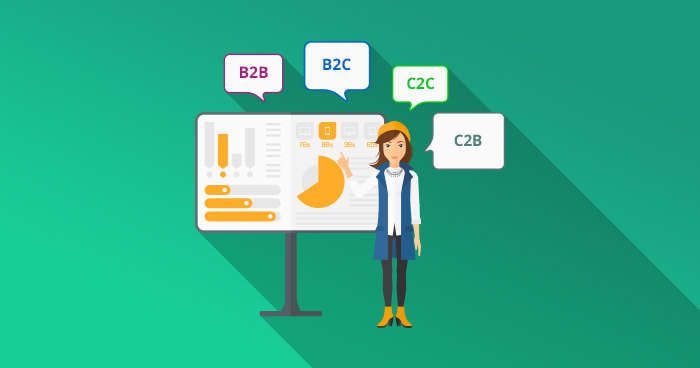In today’s digital age, the e-commerce landscape has exploded, offering a multitude of opportunities for entrepreneurs and established businesses alike. As the world increasingly shifts towards online shopping, understanding the various e-commerce business models is crucial for success in this competitive arena. From traditional retail models to innovative subscription services and dropshipping strategies, each approach presents unique advantages and challenges. We will look into the top e-commerce business models
Business-to-Consumer (B2C)
B2C e-commerce involves selling products or services directly to consumers. This model is characterized by a focus on marketing, branding, and customer experience.
Examples: Amazon, Nike, Apple
Key characteristics:
-
- Direct sales to end users
- Emphasis on branding and customer loyalty
- High transaction volume, low average order value
- Focus on customer experience and satisfaction
-
- Focus on customer experience and satisfaction
Advantages: Large potential customer base, direct control over customer experience, opportunity for recurring revenue (subscriptions).
Challenges: High competition, customer acquisition costs, and managing returns
Business-to-Business (B2B)
B2B e-commerce involves transactions between businesses. This model often includes complex sales processes, long-term relationships, and bulk orders.
Examples: Alibaba, Grainger, Dell
Key characteristics:
-
- Focus on building strong business relationships
- Complex sales cycles and longer buying processes
- Higher average order values
- Emphasis on product quality and reliability
Advantages: Potential for larger and more consistent revenue, deeper customer relationships.
Challenges: Complex sales processes, longer sales cycles, need for specialized sales teams.
Business-to-Government (B2G)
B2G e-commerce involves selling products or services to government agencies. This model requires specific compliance and bidding processes.
Examples: Government procurement portals
Key characteristics:
-
- Complex procurement processes
- Rigorous bidding and tendering requirements
- Long sales cycles
- Emphasis on trust and security
Advantages: Potential for large contracts, stable revenue streams.
Challenges: Bureaucratic processes, lengthy contract negotiations, and compliance requirements.
Consumer-to-Consumer (C2C)
C2C e-commerce involves transactions between individuals. This model has gained popularity with the rise of online marketplaces.
Examples: eBay, Craigslist, Etsy
Key characteristics:
-
- Peer-to-peer transactions
- Wide range of products and services
- Potential for counterfeit goods
- Reliance on platform trust and reputation
Advantages: Low barriers to entry, large potential customer base, opportunity for niche markets.
Challenges: Trust and safety concerns, potential for fraudulent activities, competition.
Consumer-to-Business (C2B)
C2B e-commerce involves individuals selling products or services to businesses. This model is often associated with freelance platforms and crowdsourcing.
Examples: Upwork, Fiverr
Key characteristics:
-
- Competitive bidding
- Project-based work
- Variable pricing
- Emphasis on skills and expertise
Advantages: Flexible work arrangements, potential for high earnings, direct client interaction.
Challenges: Inconsistent income, competition for jobs, and managing client relationships.
Business-to-Business-to-Consumer (B2B2C)
B2B2C involves a business selling products to another business, which then sells them to consumers. This model combines elements of B2B and B2C.
Examples: Manufacturers selling products through retailers
Key characteristics:
-
- Complex supply chain management
- Focus on both business and consumer needs
- Brand management at multiple levels
- Potential for conflicts of interest
Advantages: Expanded market reach, potential for increased sales, shared marketing efforts.
Challenges: Coordinating multiple parties, maintaining brand consistency, and managing inventory.
Freemium model
The freemium model is a business strategy where a basic product or service is offered for free, while advanced features or additional services are available for a premium price.
Examples: Spotify, Dropbox
Advantages: Large user base, data collection and customer acquisition
Challenges: Monetization, free feature, and user retention
Subscription box Model
A subscription box model involves delivering curated products or services to customers on a recurring basis for a fixed fee.
Examples: Birchbox, Dollar Shave Club
Advantages: Recurring revenue, customer retention, and higher average order value (AOV)
Challenges:
- Inventory management: Managing product selection and supply chain.
- Customer acquisition: Attracting new subscribers can be challenging.
- Customer retention: Retaining subscribers requires consistent value and innovation.
Dropshipping model
Dropshipping is a retail fulfillment method where a store doesn’t keep the products it sells in stock. Instead, when a store sells a product, it purchases the item from a third party and has it shipped directly to the customer.
Advantages: Low startup costs, wide product range, scalability
Challenges: Limited control over shipping, and product quality
Social commerce
Social commerce involves buying and selling products or services directly through social media platforms. It leverages the power of social networks to create a seamless shopping experience for consumers.
Key characteristics
- Shoppable posts: Allowing users to purchase products directly from social media feeds.
- Live shopping: Interactive shopping experiences where users can interact with hosts and other viewers.
- Influencer partnerships: Collaborating with influencers to promote products.
- Social proof: Utilizing user-generated content to drive sales.
Advantages: Direct access to customers, increased engagement, leveraging existing platforms and data-driven insights
Challenges: Platform limitations, competition, and customer service
Hybrid Models
Many businesses combine elements of different models to create unique business models. For example, Amazon operates as a B2C marketplace but also offers B2B services.
Key factors for choosing a business model
- Target market: Understanding your ideal customers is crucial.
- Product or service offerings: The nature of your products or services will influence the best model.
- Competitive landscape: Analyze how competitors operate to identify opportunities.
- Scalability: Consider how the model can grow with your business.
- Profitability: Evaluate the potential for generating revenue and profit.

